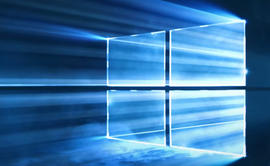 Now that Microsoft has officially launched Windows 10, there will be a big push to get users of previous versions to upgrade to the newest Windows. Microsoft is offering a “free” upgrade to most non-business users of previous Windows versions (Windows 7, 8, and 8.1, but not XP and previous). In addition, Microsoft is (literally) pushing the upgrade on-line, through it’s Windows Update service. If you’re eligible for a free upgrade, they have by now pushed an update to your computer that advertises the free upgrade (in the form of a small windows logo in the system tray next to the clock) and entices you to register to receive it. Should you?
Now that Microsoft has officially launched Windows 10, there will be a big push to get users of previous versions to upgrade to the newest Windows. Microsoft is offering a “free” upgrade to most non-business users of previous Windows versions (Windows 7, 8, and 8.1, but not XP and previous). In addition, Microsoft is (literally) pushing the upgrade on-line, through it’s Windows Update service. If you’re eligible for a free upgrade, they have by now pushed an update to your computer that advertises the free upgrade (in the form of a small windows logo in the system tray next to the clock) and entices you to register to receive it. Should you?
If you’re on Windows 8.1 (or – shudder – still on Windows 8), you should absolutely take the leap to Windows 10. Windows 8 was such an unmitigated disaster (which the 8.1 upgrade only marginally fixed) that the jump to 10 is a no-brainer. Technically, the system requirements are the same (and possibly even better for RAM requirements), so there should be no reason that your Windows 8/8.1 system couldn’t handle the upgrade to 10). Most of the tablet/touch functionality has been preserved or improved, and the desktop (keyboard & mouse) mode has been restored to something that’s usable (which 8/8.1 wasn’t). There are also other improvements, such as the new Edge browser, which shows promise to finally kill the beast that IE has become. Pull the trigger on the upgrade now!
If you’re still on Windows 7, it’s not as clear a decision. Sure there is the bright, shininess to W10, but there is also a significant user retraining (arguably, much smaller than W8/8.1). If you’re so used to doing things a certain way (and that way works for you), then W10 might change that a little or a lot – and for what benefit? Speed? Security? Additional functionality? W10 only marginally improves all of these areas. For most W7 users, there is not a compelling reason to upgrade (just yet). Of course, this may change after MI would expect businesses to take much longer to push users into W10, probably as part of an overall hardware replacement schedule. icrosoft starts adding functionality this Fall. Oh didn’t you hear? They promise much more frequent updates and new features (the equivalent of mini service packs), all released and forced down your throat pushed to your computer through the update service.
Of course, if your computer is part of a business domain, you won’t get a choice either way. Your system administrator (people like me) and IT department will decide whether to upgrade your systems. Oh, and those upgrades won’t be free. Microsoft would like your licensing money, thank you very much. Arguably, this initial version of 10 is primarily for home and student consumers (and the release date is timed for back-to-school purchase). Many necessary business features aren’t included and will be coming later this year (or even next year), so this W10 really isn’t ready for business yet. I would expect businesses to take much longer to push users into W10, probably as part of an overall hardware replacement schedule.
So if you’re buying a new system, Windows 10 is just fine. Have a current W8/8.1 system? By all means, get the upgrade. Still on Windows 7? I’d hang out awhile and watch what happens…
Posted: July 29th, 2015 under Microsoft, Operating Systems, Technology, Windows, Windows 10.
Comments: none
